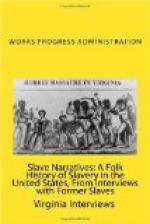“We raised a lot of corn, and castor beans. That was the money crop. Corn at that time wasn’t hard to raise. People never plowed their corn more than three times, and they got from forty to fifty bushels per acre. There were no weeds and it was virgin soil. One year I got seventy-two bushel of corn per acre, and I just plowed it once. That may sound ‘fishy’ but it is true.”
“There used to be a castor bean mill here, and I have seen the wagons of castor beans lined from Logan Street to First Street, waiting to unload. They had to number the wagons to avoid trouble and they made them keep their places. There also used to be a water mill here, but it burned.”
“There were lots of Indians here in the Chippewas. They were harmless though. They were great to come in town, and shoot for pennies. They were good shots, and it kept you going to keep them supplied with pennies, for them to shoot with their bows and arrows, as they almost always hit them. They were always dressed in their red blankets.”
“I have never used ones for work. They were used quite a bit, although I have never used them. They were considered to be good after they were broken.”
“I was about twenty-two years old when I married, and I have raised six children. They live over by Appanoose. I ruined my health hauling wood. I was always a big fellow, I used to weigh over two hundred eighty-five pounds, but I worked too hard, working both summer and winter.”
“My father’s mother lived ’till she was around ninety or a hundred years old. She got so bent at the last she was practically bent double. She lived about two years after she was set free.”
“I used to live up around Appanoose, but I came to Franklin County and I have stayed here ever since.”
THE AMERICAN GUIDE TOPEKA, KANSAS
Ex slave story
Ottawa, Kansas
interviewer: Leta Gray
Told by Bill Simms, ex slave, age 97 years, Ottawa, Kansas. [TR: Information moved from bottom of last page.]
“My name is Bill Simms.”
“I was born in Osceola, Missouri, March 16, 1839.”
“I lived on the farm with my mother, and my master, whose name was Simms. I had an older sister, about two years older than I was. My master needed some money so he sold her, and I have never seen her since except just a time or two.”
“On the plantation we raised cows, sheep, cotton, tobacco, corn, which were our principal crops. There was plenty of wild hogs, turkey, ant deer and other game. The deer used to come up and feed with the cattle in the feed yards, and we could get all the wild hogs we wanted by simply shooting them in the timber.”
“A man who owned ten slaves was considered wealthy, and if he got hard up for money, he would advertise and sell some slaves, like my oldest sister was sold on the block with her children. She sold for eleven hundred dollars, a baby in her arms sold for three hundred dollars. Another sold for six hundred dollars and the other for a little less than that. My master was offered fifteen hundred dollars for me several times, but he refused to sell me, because I was considered a good husky, slave. My family is all dead, and I am the only one living.




